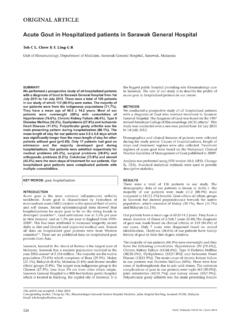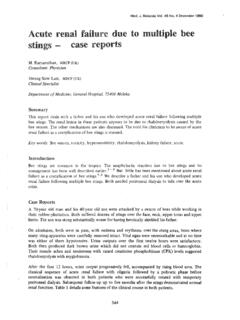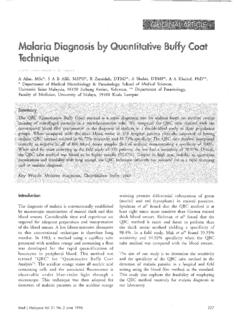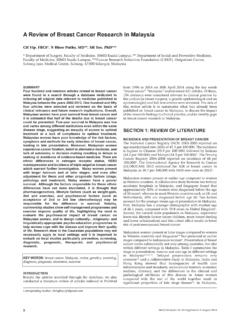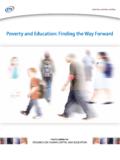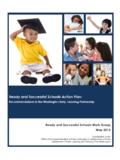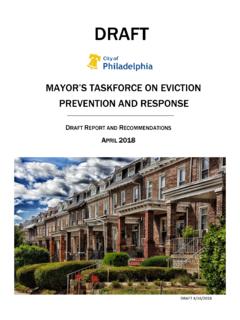Transcription of A review of teenage pregnancy research in Malaysia
1 214 Med J Malaysia Vol 70 No 4 August 2015 ABSTRACTO bjective: To summarise the published research on teenagepregnancy in Malaysia , discuss the impact of the findings onclinical practice, and identify gaps in teenage pregnancyresearch in : There were 31 articles related to teen pregnancyfound after searching a database dedicated to indexing alloriginal clinical research data published in Malaysia fromyear 2000 to 2014. Twenty-seven articles (including reportsfrom the National Obstetrics Registry) were selected andreviewed on the basis of clinical relevance and futureresearch implications. This literature review has beendivided into eight sections: epidemiology, age at firstmarriage, adolescent fertility rate, unmarried childbearing,risk factors, maternal risks and neonatal outcome, futureplan after delivery, and contraceptive use.
2 Results: More than 19,000 births to teenage mothers wererecorded each year between 2009 and 2011. Adolescentfertility rates were recorded at 6 births per 1000 women ages15 19 years in 2013. Many of these births were from unwedpregnancies, which accounted for of total majority of young mothers were willing to take care of theirbaby, although some of them planned to put their baby upfor adoption. Risk factors for teenage pregnancy were foundto be similar to those published in studies : More research is needed to better understandthe issue of teen pregnancy . For the best results,collaborative studies among nationwide hospitals andinstitutions should be the way forward. KEY WORDS:Adolescent, contraception, Malaysia , teen pregnancy , unmarriedINTRODUCTIONTeen pregnancy is defined as any pregnancy occurringamong adolescent girls aged 19 years or recentdecades, the number of teens who have become pregnantworldwide has increased and become a major health issue forboth developing and developed countries.
3 It is estimated thatin 2010, there were over billion young people globally,with 90% living in developing worrying isthe fact that in many countries, women aged 20 24 years arelikely to have been married before age impacts of teenage pregnancy are many, mostly affectingthe health of the mother as well as that of the to denial and fear of rejection by their family,pregnant teenage mothers tend to skip antenatal care and inthe worst case scenarios, do not booked their pregnancy , teenage pregnancy can disrupt a girl shealthy development and prevent her from achieving her fullpotential and enjoying her basic human rights. The effects ofthis can include social isolation, low academic achievement,nutritional depletion, low income-earning potential, andlifelong impacts of teen pregnancy can echothroughout a girl s entire life and carry over to the Malaysia , there were more than million young peoplein the age group 10-19 years in 2010, constituting of the total such vast numbers ofteens, it is important to review the scenario of teenagepregnancy using local data.
4 The aim of this review is tosummarise the published literature on teenage pregnancy inMalaysia, to discuss the impact of research findings in termsof clinical practice, and to identify gaps in research onteenage pregnancy in Malaysia . MATERIALS AND METHODSA literature search of articles was carried out (as described in Bibliography of clinical research in Malaysia : methods andbrief results ),9and 18 articles on teenage pregnancy inMalaysia were retrieved. The authors also searched forrelated articles indexed in PubMed, Scopus and other healthjournals between 2000 and 2014, accessed on 15 September2014 using the keywords teen pregnancy , teenagepregnancy , adolescent pregnancy , and Malaysia .
5 Intotal, there were 35 articles related to teen pregnancy foundvia a database search. Twenty-seven articles (includingreports from the National Obstetrics Registry) were selectedby the authors (a medical officer, a family medicinespecialist, and an obstetrician) for review , on the basis ofclinical relevance and future research and IncidenceThe incidence of teenage pregnancy in Malaysia has beenrecorded since the 1960s. According to Tey, the incidence ratefor teenage pregnancy in 1964 was 10% (n = 33,348) of 1984, this rate had reduced to (n = 18,172).Since then, the number of births to teens has declined. In2010, using data from the National Obstetrics Registry(NOR), 7077 cases of teenage pregnancy were reported from14 general hospitals in figure can beA review of teenage pregnancy research in MalaysiaMohd Azri Mohd Suan, MBBS*, Adibah Hanim Ismail, MMed (Family Medicine)**, Haliza Ghazali, MOG**Clinical research Center, Sultanah Bahiyah Hospital, Alor Setar, Kedah,**Faculty of Medicine and Health Sciences, UniversitiPutra Malaysia , Serdang, Selangor,**Department of Obstetrics & Gynaecology, Sultan Abdul Halim Hospital, Sungai Petani,KedahORIGINAL ARTICLE This article was accepted: 14 May 2015 Corresponding Author.
6 Mohd Azri Mohd Suan, Clinical research Center, Sultanah Bahiyah Hospital, KM 6, Jalan Langgar, 05460 Alor Setar, KedahEmail: review of teenage pregnancy research in MalaysiaMed J Malaysia Vol 70 No 4 August 2015215translated to 5% of total deliveries or 50 per every 1000deliveries. Vital Statistics Reports have also revealed a similardecreasing trend in the incidence of teenage to teenagers (10-19 years old) declined to (n =19,215) in 200912and (n = 18 253) in 2011,the recorded number of births to teens was slightly higher (n = 19 538), of which 228 births were to girls under figure was lower than World Health Organization(WHO) statistics stating that about 11% of teenage girls givebirth rate of births to teen mothers washigher in Sabah and Sarawak states, representing (n =4124) and (n = 3996) of total births, was the largest ethnic group with teen births ( ,n = 7863)
7 In Peninsular Malaysia , compared with at First MarriageAge at first marriage has implications for women s healthand fertility Malaysian family law hassome restrictions on teen marriage (teenagers aged 18 andbelow need parental consent to marry whereas Muslim girlsbelow age 16 years can marry with the permission of Shariaauthorities),17there are still a large number of young womengetting married at an early age. The Malaysian Populationand Family Survey (MPFS) conducted in 2004 estimated thatsome of 3700 married women in Peninsular Malaysiahad married before the age of 15 years, and marriedbetween 15 and 19 years the same survey, it wasfound that the proportion of women from Sabah state whomarried before 19 years of age was much higher than otherstates ( married under age 15 and marriedbetween 15 and 19 years old).
8 The 2010 Population and Housing Census found that nearly60% of the population aged 15 years and over was marriedand only reported being same reportalso revealed that 84,261 girls and 74,071 boys between theages of 15 and 19 were already Fertility RateThe adolescent fertility rate is defined as the annual numberof births to women aged 15 19 years per 1000 women in thatage group,19and represents the risk of childbearing amongthem. The adolescent fertility rate in Malaysia has declinedfrom 32 per 1000 women aged 15 19 years in 1980 to 19 in1990, and this was further reduced to 14 in the year 2000. By2013, the recorded rate was 6 births per 1000 women aged15 19 the adolescent fertility rates in thiscountry are relatively low compared with many othercountries, they might not reflect the actual figure in view ofrising cases of illegal abortion and abandoned babies amongteenagers.
9 Non-marital ChildbearingRuhaizan et 5200 cases of unwed pregnanciesbetween 2011 and 2012, which accounted for about oftotal highest incidence of unwed pregnancywas reported at Sarawak General Hospital in 2011 with 446cases and Kuala Lumpur General Hospital in 2012 with 377cases. This worrying trend of non-marital childbearing isamplified by statistics from the National on these, 38,258 of the 472,983 births in2006 were registered as illegitimate child status, the termused to refer to children born out of wedlock. This figure hassurged every year since then, with nearly 53,000 of 510,462births recorded in 2013 registered with this Factors for teenage PregnancyVarious factors contributing to this predicament have beenstudied.
10 Key risk factors for teenage pregnancy includepoverty, inadequate parental supervision, low educationalexpectations, and peer influence. Many of these likely relateto social disadvantage. Other risk factors are summarised inTable I. PovertyResearch carried out by the United Nations Children s Fund(UNICEF) Malaysia revealed strong evidence that teenagepregnancy is associated with higher rates of poverty, withteen mothers ending up either unemployed or in low finding is in line with results from a case-controlstudy of 102 adolescent participants and 102 adult controls atKuala Lumpur General Hospital and Universiti KebangsaanMalaysia Medical Centre. teenage mothers were found tohave significantly lower socioeconomic status during theirpregnancy compared with their adult counterparts ( , p < ).



